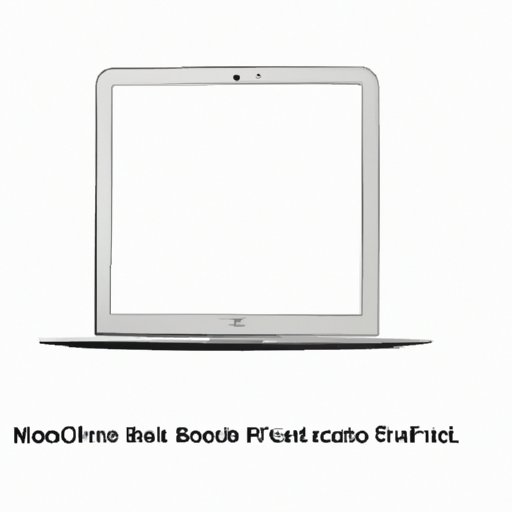Introduction
Is your MacBook Air running slower than usual? Are you experiencing frequent crashes or software errors that won’t go away? One effective way to address these issues is by resetting your laptop to its factory settings. A factory reset wipes your MacBook Air clean and restores it to its original software configuration, just like it was fresh out of the box. In this article, we’ll guide you through the entire process of resetting your MacBook Air, from preparation steps to troubleshooting tips and best practices.
Step-by-Step Guide
Before diving into the reset process, let’s first define what a factory reset is and how it differs from a regular reset. A regular reset simply restarts the MacBook Air and closes any open programs or windows, while a factory reset erases everything on the laptop’s hard drive and reinstalls the original operating system.
To begin, follow these step-by-step instructions for resetting your MacBook Air to its factory settings:
1. Back up your important files: Before resetting your MacBook Air, make sure to back up any important files or data to an external hard drive or cloud storage service. A factory reset will erase everything on the laptop’s hard drive, so it’s essential to create a backup first.
2. Sign out of iCloud: If you’re signed in to iCloud on your MacBook Air, make sure to sign out before starting the reset process. To do this, go to Apple menu > System Preferences > iCloud and uncheck everything. Then click Sign Out.
3. Restart your MacBook Air in Recovery mode: To access the MacBook Air’s recovery partition, restart your laptop while holding down the Command + R keys until the Apple logo appears. This will load the macOS Utilities window.
4. Erase your hard drive: In the macOS Utilities window, select Disk Utility and click Continue. Then select your primary hard drive and click Erase. Choose Mac OS Extended (Journaled) as the format, give the drive a name, then click Erase to wipe the drive’s contents.
5. Reinstall macOS: After erasing the hard drive, click Reinstall macOS in the macOS Utilities window. Follow the onscreen instructions to reinstall the operating system. This may take some time, depending on your MacBook Air’s hardware and internet speed.
6. Set up your MacBook Air: Once the reinstallation is complete, your MacBook Air will restart and prompt you to set up the laptop like it’s new. Follow the instructions on the screen to choose your language, time zone, and other preferences. You can then restore your backup files and start using your MacBook Air again.
Troubleshooting Guide
Although resetting your MacBook Air can solve many software issues, you may encounter some problems during the process. Here are some common issues and their solutions:
1. MacBook Air won’t enter Recovery mode: If your laptop won’t enter Recovery mode when you restart it, try resetting the System Management Controller (SMC) by holding down Shift + Control + Option + Power button for a few seconds.
2. Disk Utility can’t erase the hard drive: If Disk Utility reports an error when trying to erase your MacBook Air’s hard drive, it could be due to faulty hardware. Contact Apple Support for help.
3. macOS won’t reinstall: If the macOS installation fails or stops midway, restart your MacBook Air and try again. If it still doesn’t work, try booting from an external installation disk or contact Apple Support.
4. Can’t restore backup files: If your backup files won’t restore after the reset, make sure they’re compatible with your MacBook Air’s new operating system version. You may need to update your backup software or manually transfer files.
Best Practices
To ensure a smooth reset process and optimal laptop performance, here are some best practices to follow:
1. Back up your files regularly: Don’t wait until you need to reset your MacBook Air to back up your files. Use cloud storage services like iCloud or Google Drive, or an external hard drive to save your important files regularly.
2. Keep your MacBook Air updated: Regularly update your laptop’s software to get the latest security patches and performance improvements. Go to Apple menu > System Preferences > Software Update to check for updates.
3. Check for hardware issues: Before resetting your MacBook Air, make sure there are no hardware issues by running Apple Diagnostics. To do this, restart your laptop while holding down the D key until the diagnostic test begins.
4. Keep your MacBook Air clean: Keep your MacBook Air’s keyboard, screen, and ports clean by wiping them with a soft, dry cloth regularly. Avoid using water or harsh cleaning chemicals.
5. Follow the reset instructions carefully: Make sure to follow each step of the reset process carefully, and don’t skip any necessary preparation steps. Forgetting to back up your files or sign out of iCloud can lead to data loss or other issues.
Video Tutorial
For an even more comprehensive guide to resetting your MacBook Air, check out this video tutorial:
[Insert video tutorial link or embed here]
Comparing with other MacBooks
The process of resetting a MacBook Air is similar to resetting other types of MacBook, such as the MacBook Pro. However, the specific steps and preparation may differ slightly depending on the type of laptop and its operating system version. If you’re unsure of how to reset your MacBook Pro or other MacBook models, consult Apple Support or follow our guide for the MacBook Air.
Conclusion
Resetting your MacBook Air to its factory settings can seem daunting, but with our step-by-step guide and troubleshooting tips, it doesn’t have to be. By following the instructions carefully, backing up your files, and implementing best practices, you can ensure a smooth reset process and optimize your laptop performance.
